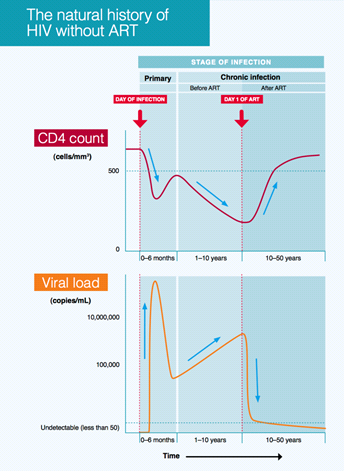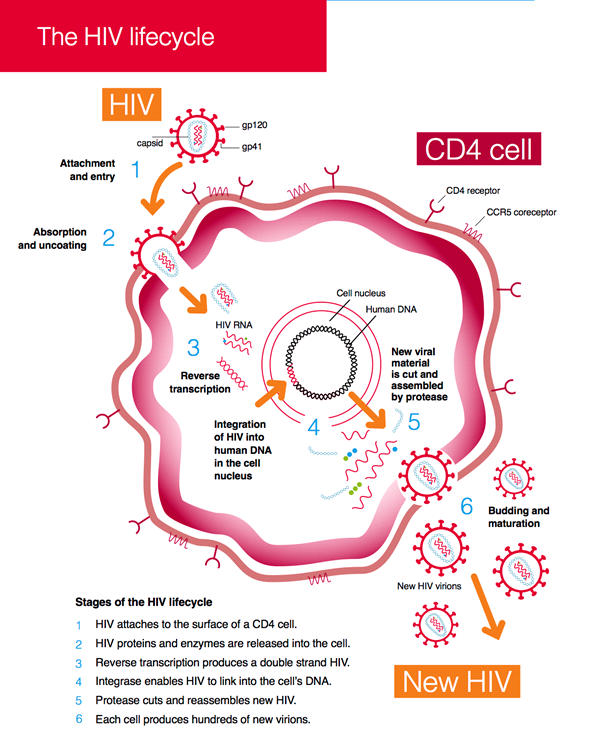HIV is a virus that weakens immune systems in people. HIV is short for human immunodeficiency virus. Immunodeficiency means an impairment of the immune system.
In brief
- If left untreated, HIV can lead to AIDS
- The immune system cannot get rid of HIV by itself
- When the virus is suppressed, people with HIV will not get AIDS and cannot transmit HIV
- HIV can hide in different parts of the body (this is called the viral reservoir) and this is the biggest barrier to finding a cure
HIV
Your immune system is no longer able to fight off pathogens effectively because of HIV. So you can get infections. Someone who doesn't have HIV can fight off those infections, no problem. With HIV this is no longer possible, unless you take HIV medication.
There are different ways of contracting HIV. Read more here about how HIV can be transmitted.
When a person contracts HIV, the initial infection is acute and this later changes into a chronic infection. An HIV infection is a serious, but easily treated, condition. If left untreated, HIV can lead to AIDS. Read more here about AIDS.
With proper HIV treatment, your life can be as long and as healthy as someone without HIV. About half of the people with HIV rate their health as being good to excellent. Less than one in ten rates their health as being very poor. Also, the life expectancy of people in the Netherlands with HIV is the same as people without HIV. To stay healthy, it is important that you do not wait too long before you start using HIV medication, and that you take it on time every day.
Get good information
There is a lot to deal with when you are told you have HIV. You will have to make decisions like: who do you tell the news to, how do you handle sex, what do the blood results mean, and how do you stay healthy? Above all, take your time to get used to the new situation.
Don't forget, there is a lot of incorrect and outdated information about HIV on the internet. So always check carefully whether the information is up to date and whether the source is reliable. A lot has changed in recent years. On our website, we try to always provide the most up-to-date information on living with HIV. Additionally, you can find information about HIV in leaflets (Dutch and English), the workshop series offering support and information, and of course you can ask questions at the hospital.
If you are looking for a personal chat or advice, call the Servicepunt (Service Desk) at the Hiv Vereniging: 020-689 25 77 – Mondays, Tuesdays and Thursdays from 14.00 to 22.00.
The immune system
The body’s defence system (also known as the immune system) protects the body from infection by invading microorganisms, such as bacteria and viruses. When viruses or bacteria start to grow at the expense of your body, and damage your body's cells as a result, we call this an infection.
For this defence to operate properly, it is essential that the immune cells recognise the pathogens, and spring into action to render them harmless. It is a complex defence system of cells that communicate with each other and give each other commands. The immune system is constantly working on this, even though we don't notice it. The immune system is able to render most infections harmless, but unfortunately it cannot do that with HIV.
When your body comes into contact with a pathogen, your immune system reacts to it. White blood cells (also called leukocytes), antibodies, and certain immunological agents provide the defence. Out of these white blood cells, the T-helper cells (these are CD4 cells) are the ones that direct the operation. T cells activate the rest of the immune system when needed. But the HIV virus can invade CD4 cells, and T cells are CD4 cells. This disrupts the immune system. CD4 cells are not only found in the blood, but also in the lymph nodes and in all other tissues in your body. If you don't treat the HIV infection with medication, the CD4 count in the blood can drop sharply. This puts you at risk of serious infections.
By measuring the number of CD4 cells you can get an idea of how well the immune system is working. That is because HIV kills CD4 cells. When the CD4 count is very low (below 200, for example) the immune system is probably not working well enough to suppress infections that would not make someone with a good immune system sick.
When you get a viral infection, the immune system produces antibodies to protect your body. Blood tests can show the presence of antibodies, which indicates that an infection has occurred. Your body produces antibodies when confronted with HIV. If an HIV test detects these antibodies in your blood, that means you are HIV-positive. Even when the virus in your body is unmeasurable after taking medication, the HIV test will still be positive: the antibodies are still there.
The course of an HIV infection

bron: i-Base
Explanation of illustration
- CD4 count = the number of immune cells
- Viral load = the amount of virus in your blood
- Primary infection = acute infection
- Chronic infection = chronic infection
- ART = antiretrovirals, this is HIV medication
The illustration shows an example of the viral load and immune cell count of a person in the acute phase (0-6 months), the chronic infection without medication (1-10 years) and the chronic infection with medication (10-50 years). This illustration demonstrates how an HIV infection can develop. However, it is always best to start the medication as soon as possible after being infected.
Acute infection
Your body does not know how to react in the immediate aftermath of being infected. This phase is called the acute or primary infection. This is the initial timeframe (0-6 months) in the example in the illustration above. HIV is free to undermine your immune system without it fighting back. The number of immune cells (CD4 cells) then begins to drop. The consequences are that your defences weaken rapidly and you become sick. Your immune system needs time to learn how to deal with HIV, and the number of immune cells will rise again after a while.
During the acute phase, you may experience the following: flu-like symptoms, sore throat, fever, general malaise, rashes, headaches behind the eyes, and swollen lymph nodes. Not everybody gets these symptoms, and they could also be caused by a flu. If you experience symptoms or indications of disease, do not hesitate to go to your general practitioner, or the GGD (Municipal Health Service). They can give you more information, and possibly offer you an HIV test. Read more here about testing for HIV.
Chronic infection without medication
By the time the acute or primary HIV infection is over, your body will have learnt to deal with HIV. You then have a chronic infection. This is the second timeframe (1-10 years) in the example in the illustration. Your immune system is clearing out the infected cells and making antibodies to prevent HIV from infecting more cells. Your immune system recovers, your symptoms disappear, and you start to feel better. However, HIV is almost always stronger than your defences, unless you take medication. The result is that your immune system gets weaker over time. This means you are more susceptible to all kinds of infections. This process varies from person to person as well. Some people still feel healthy years after contracting HIV, others get sick quite soon.
Whether and when you get symptoms and illnesses, varies from person to person. The most important symptoms and illnesses are:
- Fatigue
- Diarrhoea
- Weight loss
- Shortness of breath
- Swollen or inflamed lymph nodes
- Anaemia or other blood abnormalities
- Fever
- Night sweats
- Tingling in hands/arms and/or feet/legs
- Fungal infections
- Recurring cold sores or shingles
- Eczema
- Other STI’s, such as hepatitis B or C
Chronic infection with medication
In the third timeframe in the example in the illustration (10-50 years), the person has a chronic infection and is taking HIV medication. Medication helps the immune system to keep the virus suppressed. This means the immune system does not have to work as hard, and the person will not get AIDS. So HIV is a disease that is easy to treat. The earlier you start taking HIV medication, the smaller the chance of complications later on. And when someone with a chronic infection takes medication, the virus is so well suppressed that it cannot be passed on through sex.
The virus

Bron: i-Base
Explanation of illustration
- CD4 cell = immune cell, a T-helper cell or a macrophage (both white blood cells)
- CD4 receptor = lock on the cell HIV attaches itself to
- CCR5 = the co-receptor on a T-helper cell, part of the lock
- CXCR4 = the co-receptor on a macrophage, part of the lock
- Gp120 = the key on HIV’s cell wall that fits into the CD4 receptor and the co-receptor
- Gp41 = needed for HIV to penetrate a human cell
HIV infects white blood cells that have a CD4 receptor. Examples of this are T-helper cells and macrophages. A T-helper cell is the director of the immune system, controlling other immune cells. A macrophage is a cell that clears out dead cells.
HIV is a retrovirus. Retroviruses have RNA instead of DNA. DNA and RNA are genetic materials that record a cell’s function. HIV penetrates human cells, converts its own RNA into DNA and incorporates it into the human DNA. This allows HIV to replicate itself inside a human cell. This is what makes it so difficult to find a cure for HIV. There are other retroviruses as well as HIV.
The CD4 receptor is a kind of lock that a key will fit into. HIV needs this white blood cell lock and a key of its own to penetrate the cell. The lock consists of the CD4-receptor and the CCR5 (in T-helper cells), or the CXCR4 co-receptor (in macrophages). The key is a protein on the cell wall of the HIV, the protein is called gp120. HIV also needs the gp41 protein to penetrate the cell.
HIV uses the following steps to replicate itself in the human body:
- HIV uses its gp120 protein to bind to the cell wall of a CD4 cell via the CD4 receptor, in combination with the CCR5 co-receptor or the CXCR4 co-receptor
- HIV proteins are released into the cell in the form of RNA, with the help of the gp41 protein
- Reverse transcriptase converts HIV’s RNA into DNA
- The enzyme integrase ensures that HIV’s DNA penetrates the DNA of the CD4 cell
- The enzyme protease breaks down and organises new HIV particles
- The CD4 cell secretes new HIV particles
Click here to read more about how HIV medication intervenes in the replication and suppresses the virus.
Viral load
The amount of virus in the body is called the viral load. The viral load indicates how much HIV RNA is in the body. The viral load can be anything from several million to so low that it is impossible to determine the number. We call this unmeasurable (undetectable). Usually it is less than 50, sometimes the measurement limit is even lower or slightly higher. When the viral load is suppressed (less than 200 copies/ml) there is very little virus in the body and HIV cannot be transmitted through sex. We call this undetectable = untransmittable. You can read more about it in the U=U dossier (in Dutch: n=n).
If you are not yet on HIV medication, a viral load below 10,000 is on the low side. The sooner you start taking HIV medication, the better it is for your long-term health. It is good to always keep the viral load as low as possible, that keeps the viral reservoir as small as possible.
Als je nog geen hiv-medicatie gebruikt, is een viral load onder de 10.000 aan de lage kant. Hoe eerder je begint met hiv-remmers, hoe beter het is voor je gezondheid op de langere termijn. Het is goed om de viral load altijd zo laag mogelijk te houden, zo blijft ook het viral reservoir zo klein mogelijk.
Viral reservoir
HIV infects immune cells and hides in these immune cells creating a viral reservoir. Such a reservoir can be found in the brain, lymph nodes, the thymus gland, the lungs, the spleen, the kidneys, the intestines, the sexual organs, bone marrow and blood. When the viral load is suppressed, the immune cells in the reservoir are dormant (the reservoir is then latent). The immune system cannot recognise the HIV in the latent reservoir, which means it cannot be targeted by HIV medication. When someone stops using HIV medication the immune cells in the reservoir become active again, and the virus can produce new HIV particles from the reservoir that can infect other cells. This is how the virus starts spreading again. So it is important to keep the viral reservoir as small as possible. The viral reservoir is the biggest barrier to curing HIV.
Long-term non-progressors
Around 1% to 2% of people with HIV are long-term non-progressors. Long-term non-progressors are people with HIV in whom the infection progresses differently than usual. These are people with HIV whose immune system can suppress the virus for a long time, without the help of HIV medication.
These people maintain a high CD4 cell count (more than 500 copies/ml) for more than 5 years, and sometimes as long as 10 to 15 years after infection. Without HIV medication, the viral load will eventually increase anyway, and it is not known beforehand when this will happen. Long-term non-progressors are also advised to take HIV medication, even if they have a high CD4 cell count and a low viral load.
Elite controllers
Around 1% of people with HIV are elite controllers. Elite controllers are a subgroup of the long-term non-progressors. These people retain an undetectable virus for a few years, and sometimes for decades. HIV medication is also recommended for these people because you have no idea when the viral load will start to rise.
Immune for HIV
Less than 1% of the world’s population is immune to HIV. This is usually because these people do not have a CCR5 co-receptor on their CD4 cells. This is also called the delta 32 mutation or the CCR5-Δ32 mutation. Research is being done to see if people without this mutation can also be made immune to HIV by artificially introducing a mutation. Read more here about this type of research.
Hiv-1 en hiv-2
When we talk about HIV, we are almost always talking about an HIV-1 infection. Around 95% of people with HIV have HIV-1. But there is also HIV-2, another retrovirus. HIV-1 and HIV-2 are very similar, but with a few differences. At the hospital, the doctor or nurse will tell you if you have an HIV-2 instead of an HIV-1 infection.
HIV-2 is mainly found in west Africa, and is very rare in America, Europe and Asia. In addition, HIV-2 seems to be more difficult to transmit than HIV-1. The routes of transmission are the same as for HIV-1. Not all HIV tests detect HIV-2, but the most commonly used combination test in the Netherlands will also detect an HIV-2 infection.
The course of an HIV-2 infection is also different from that of an HIV-1 infection. HIV-2 has a slower, less severe course. Treatment is also sometimes different, NNRTIs like nevirapine and efavirenz cannot be used to treat an HIV-2 infection. Other classes of HIV medication work well on HIV-2.
BIV, FIV and SIV
In addition to HIV, there are BIV, FIV and SIV. These viruses occur in animals, and are similar to HIV infections in humans. BIV stands for bovine immunodeficiency virus and occurs in cattle. FIV stands for feline immunodeficiency virus and occurs in cats. SIV stands for simian immunodeficiency virus and occurs in monkeys. The viruses can also lead to AIDS in these animals, but this does not always happen. The viruses cannot be transferred from humans to animals and vice versa.









